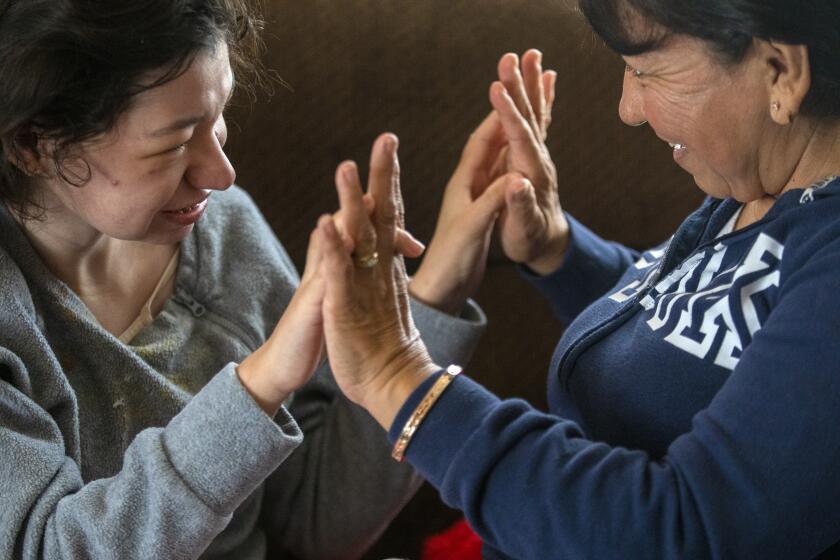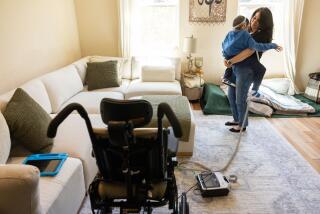Column: They take care of aging adults, live in cramped quarters and make less than minimum wage
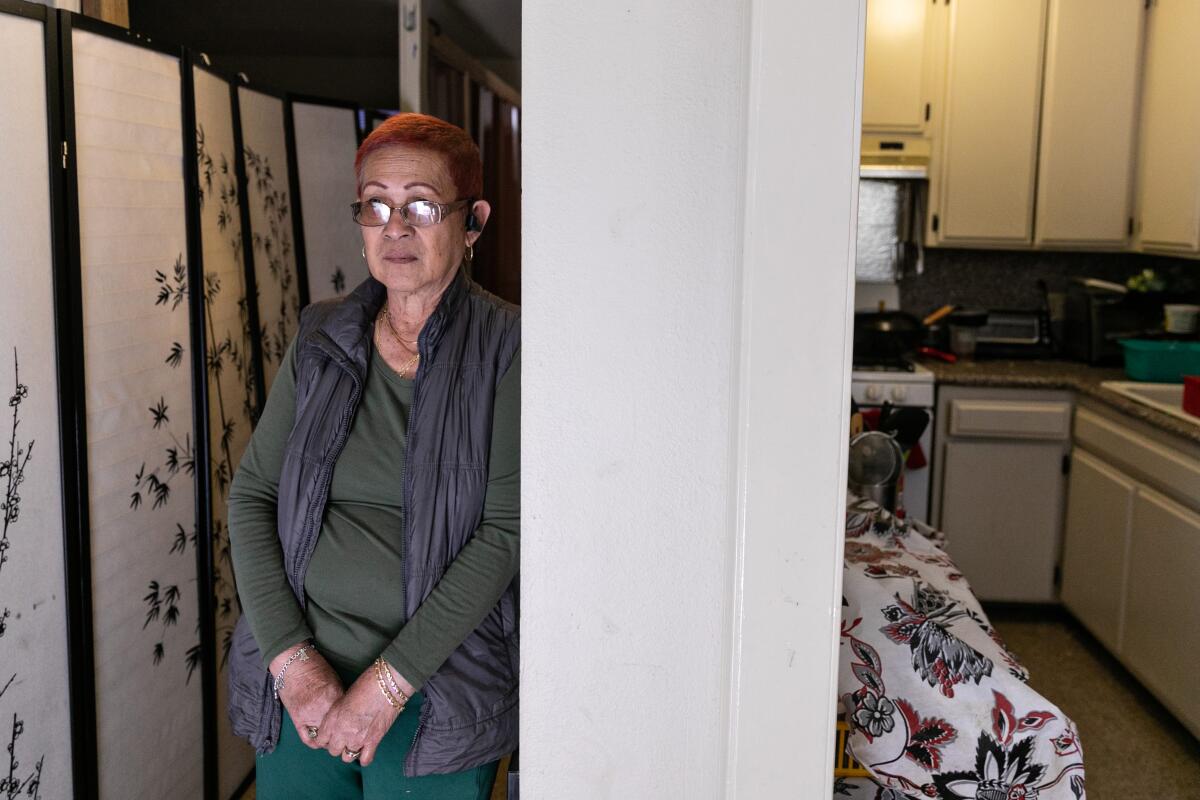
- Share via
Hard work. Long hours. Paltry wages. Isolation from relatives. Barracks-style housing.
That’s a snapshot of life for thousands of California workers who toil in the elder-care industry, which doesn’t always function well for the clients, either.
The range of experiences is dramatic. Clients of ample means are able to pay for in-home or residential facility care that can easily cost $10,000 to $15,000 a month. Low-income Californians can qualify for limited publicly financed care, which I wrote about last week.
But those who are in the middle are going broke paying for help, and a lot of people are simply going without any care at all.
As for the workers, I’ve been in homes where the caregivers are U.S. citizens with decent wages and benefits, and I’ve been in homes where the workers are undocumented and paid less than the minimum wage ($16.04 an hour in the city of Los Angeles) in cash. It’s a wink-and-nod system, much like farm labor, in which cheap labor is prized over any other consideration.
California is about to be hit by an aging population wave, and Steve Lopez is riding it. His column focuses on the blessings and burdens of advancing age — and how some folks are challenging the stigma associated with older adults.
“It’s very much a legacy of slavery and a history in this country of not valuing the work done by … people of color,” said attorney Yvonne Medrano, who heads the employee rights program at Bet Tzedek Legal Services.
Several weeks ago I reached out to the Pilipino Workers Center, a Los Angeles nonprofit that has been educating domestic workers on their rights and leading a fight against a system in which labor laws are often ignored and workers — many of them old enough to be receiving elder care themselves — are cheated and exploited.
Aquilina Soriano Versoza, the center’s director, said research indicates a majority of clients appreciate the care they get and would be willing to pay more for it, but many can’t afford to.
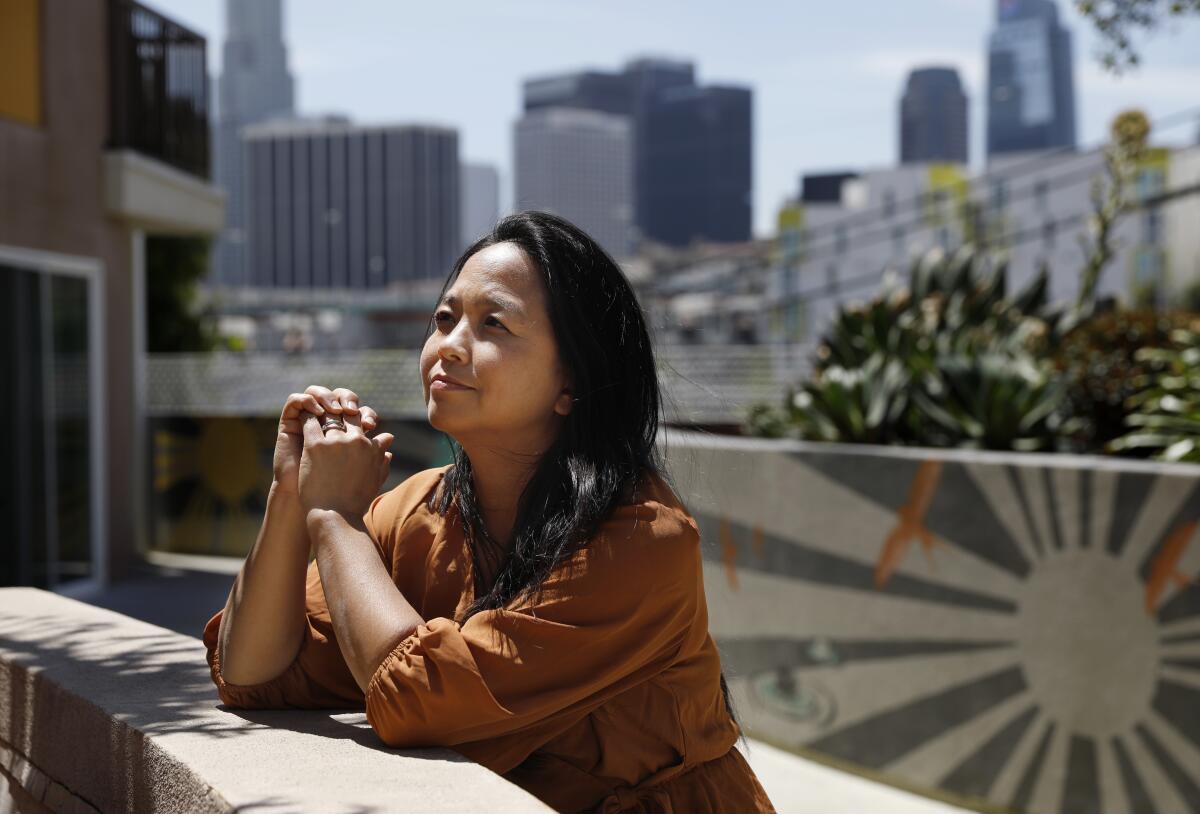
“On the workers’ side,” Versoza said, “there’s still a lot of wage theft happening, and it’s kind of a regular business model for a lot of the agencies.”
I’ve met some caregivers who, in their off time, volunteer for various organizing activities at the Pilipino Workers Center. Here are brief sketches of four of them.
Josephine Biclar, 71, is the only one of the four who is a U.S. citizen (the others asked me not to use their full names because they don’t have legal status). Biclar is limited to part-time work because her knees are worn out and she broke her shoulder when she fell in the home of an elderly client who insisted on keeping the lights off.
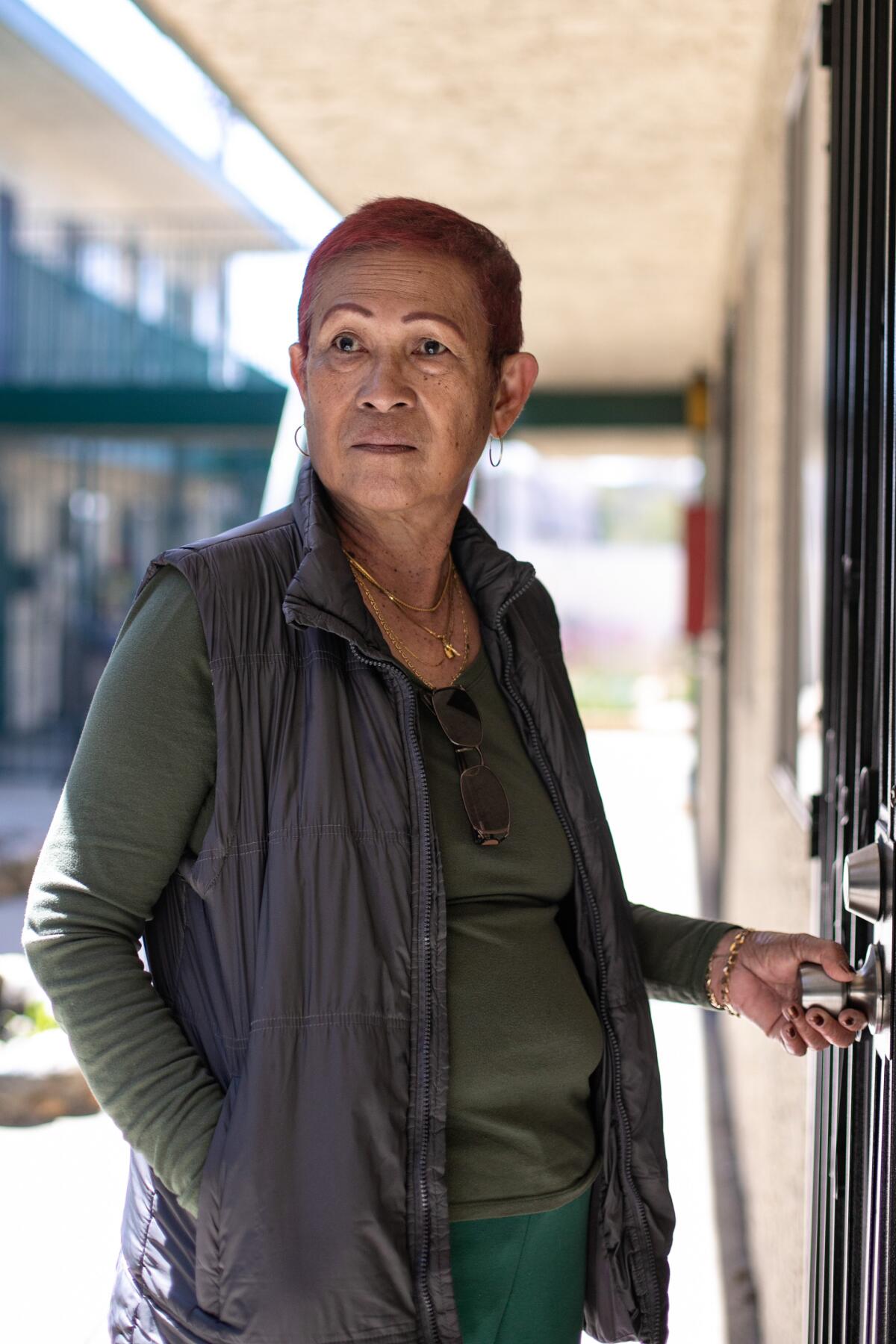
Ricky, 46, says he was routinely cursed and yelled at by an elderly client and has never been paid as much as minimum wage for changing bedpans and diapers, among other chores.
Emy, 64, is a breast cancer survivor with no health insurance. She lives in a converted garage, with no kitchen, and is still being paid less than minimum wage to care for an elderly woman even though the state won a wage theft case on behalf of her and other workers.
A.V., 55, said she was paid $30 daily for shifts that began at 5 a.m. and ended at 9 p.m., with additional work through the night when patients needed help in a private home that doubled as a nursing facility. She has moved on to other jobs only slightly less exploitative.
The workers told me they have endured these conditions because they were born into traditions of caregiving and take pride in their work, their employment options are limited, and they need to send money home to their struggling families in the Philippines.
A group of women, brought together through Los Angeles’ oldest African American church, share their struggles as caregivers for husbands, parents, siblings and grandparents.
Those who work as live-in aides can clock 100 or more hours per week and make $150 to $250 a day over a typical five-day workweek. They could be on duty 24 hours a day. State law dictates a minimum wage for the first nine hours each day and overtime pay thereafter. And yet there have been cases in which employees are averaging less than half the minimum wage.
Emy, who works five 24-hour shifts in the home of a 94-year-old client in Long Beach, was part of a settlement in which the state labor commissioner’s office ordered her employer to pay almost $2 million for wage theft, with some of the employees having averaged as little as $6.25 an hour.
But even with the victory, Emy is still making less than minimum wage as her employer appeals the ruling. Her employer did not respond to my requests for an interview.
“It’s very frustrating,” Emy said.
Medrano, the attorney, said that when workers try to go after their employers, and even when they win, the legal process can take years to play out. In the meantime, she said, some employers use various gimmicks to create new legal entities, transfer assets and avoid responsibility.
State Labor Commissioner Lilia Garcia-Brower echoed those concerns. She told me her office is greatly understaffed, despite substantial abuse in the industry, with “bad faith” employers taking advantage of workers, underpaying them and illegally classifying them as contract employees to avoid paying benefits and offering protections. The state is currently investigating 51 cases of alleged abuses.
“It’s not only … workers who are impacted, but the state as a whole,” Garcia-Brower said. “There are issues of tax evasion, workers’ compensation fraud and tax fraud that impact all of California.”
On a recent afternoon, I visited Emy in the converted Eagle Rock garage that has been her home five days a week for five years, and she said her client is playing by the rules but her employer is not.
“She pays $350 a day to the agency,” Emy said of the client, “and they pay me $210. So the agency gets $140 a day, which is the equivalent of about 40%.”
Emy, who earned an accounting degree in the Philippines and said she is helping her client do her taxes, used a calculator to determine her hourly wage for a 24-hour day.
“I get about $8.75,” said Emy, who told me she lugs two suitcases with her when she takes an Uber to Long Beach to begin her five-day shift. She packs clothes, her own food and a 5-gallon jug of alkaline water, because she thinks it can be beneficial for cancer survivors. She said she has completed training in the care of various physical conditions and Alzheimer’s, “because I care about my craft.”
The In-Home Supportive Services program pays assistants to help people who are elderly or disabled stay safely in their own homes. In Los Angeles County, IHSS caregivers make $16 an hour.
When I asked Emy why she doesn’t quit her agency and arrange to work directly for her client, she said her contract makes it virtually impossible to do that. She said it may sound to some people like a pretty good deal to get free lodging five nights a week as an in-home care provider, but you’re not in your own home, you can’t see friends or family or run personal errands, and you can never really relax.
“At the end of a hard workday, I want to put my feet up,” Emy said.
Many domestic workers share living quarters to cut expenses. Versoza told me she knew of one case in which 16 caregivers shared a home and another in which 10 shared a home.
“You see places where they’ll kind of divide up the space” with curtains or other partitions, Versoza said.
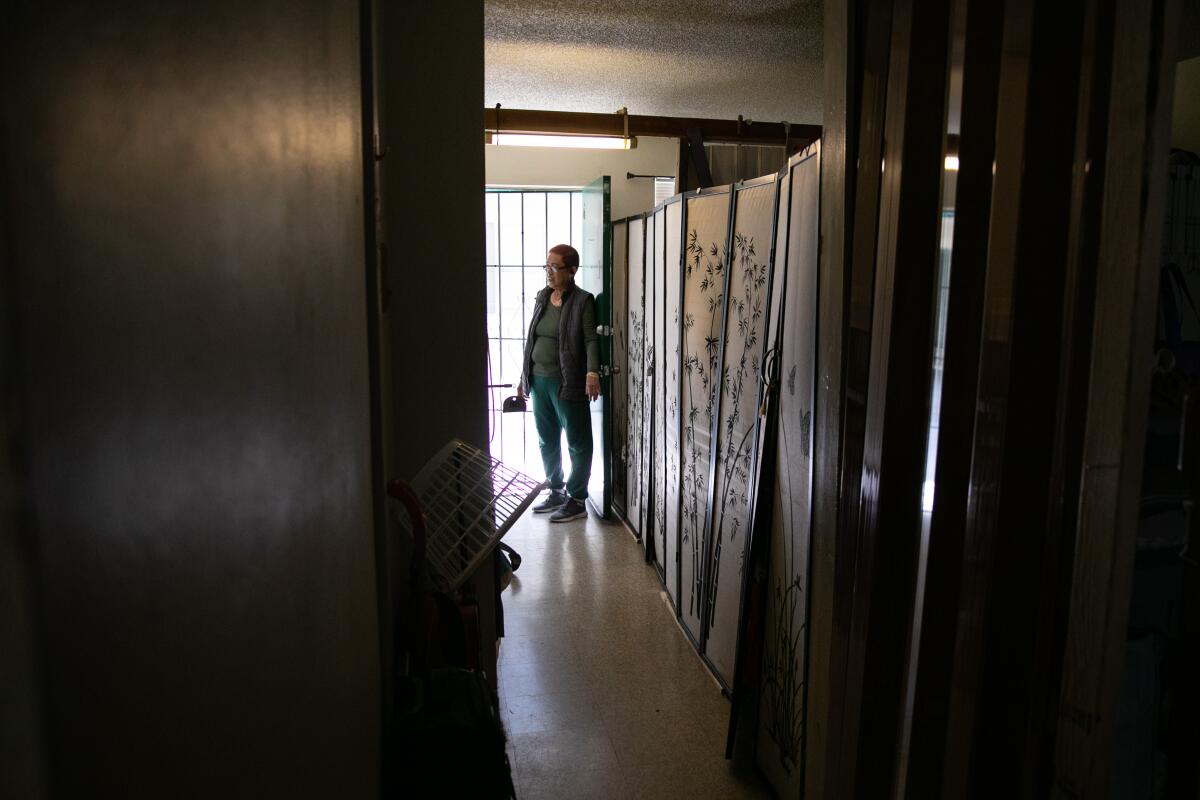
Biclar, who arrived in the U.S. in 2010 and went 12 years without seeing her grandchildren in the Philippines, showed me how this plays out in her apartment. She shares a small Panorama City studio with two other caregivers, one in her 70s and the other in her 80s.
A tight entrance leads to a small kitchen on the right. To the left is a partition created by room dividers that stand roughly head high, forming two sleeping quarters. A third sleeping compartment, Biclar’s, has accordion doors that offer at least a smidgen of privacy in a cell-like space that contains her bed and all her belongings.
Bare two-by-fours — installed by the building owner, according to Biclar — help frame the sleeping quarters. An overhead tubular fluorescent light is attached to one of the two-by-fours, secured to the beam with narrow strips of cloth.
“This is the life of a caregiver in the United States,” Biclar said, adding that more than half the 20 or so units in her apartment building are home to caregivers living in similar fashion.
None of this is acceptable, but how can it be fixed?
For starters, the governor and Legislature can make sure the state has enough resources to enforce labor laws and aggressively go after the bad-faith actors, prohibiting them from reemerging in newly formed agencies.
Get the latest in the Steve Lopez series "Golden State."
Join columnist Steve Lopez as he explores the challenges - and occasional thrills - of aging in California.
You may occasionally receive promotional content from the Los Angeles Times.
Beyond that, the state needs to prioritize its own goals — under the 10-year Master Plan for Aging — of adequate and affordable care for consumers and better pay and working conditions for workers.
Maybe workforce housing should be subsidized, and state officials should work with the congressional delegation to explore some form of legal status for workers who don’t have it. If we don’t have enough citizens interested in taking care of our elderly, immigrants who step up shouldn’t have to fear deportation while they’re changing bedpans and taking clients to medical appointments.
Maybe the state’s publicly financed In Home Supportive Services program can be expanded, with more incentives to attract new caregivers and address the current shortage.
There are no easy answers. But in the last week, Versoza and other California policymakers and advocates met at an MIT workshop, along with counterparts from New York state, with the goal of coming up with a strategy. I’ll have more on that in upcoming columns.
What’s clear is that as the country and the world age, the crisis can be seen as an opportunity, and civil societies have a moral duty to find a way forward.
More to Read
Sign up for Essential California
The most important California stories and recommendations in your inbox every morning.
You may occasionally receive promotional content from the Los Angeles Times.


